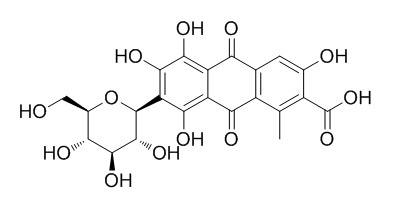Carminic acid
Carminic acid, the well-known red dyestuff from cochineal insects (Dactylopius spp.), is a potent feeding deterrent to ants. Carminic acid is an antioxidant to protect erythrocytes and DNA against radical‐induced oxidation, it also has antitumor activity.
Inquire / Order:
manager@chemfaces.com
Technical Inquiries:
service@chemfaces.com
Tel:
+86-27-84237783
Fax:
+86-27-84254680
Address:
1 Building, No. 83, CheCheng Rd., Wuhan Economic and Technological Development Zone, Wuhan, Hubei 430056, PRC
Providing storage is as stated on the product vial and the vial is kept tightly sealed, the product can be stored for up to
24 months(2-8C).
Wherever possible, you should prepare and use solutions on the same day. However, if you need to make up stock solutions in advance, we recommend that you store the solution as aliquots in tightly sealed vials at -20C. Generally, these will be useable for up to two weeks. Before use, and prior to opening the vial we recommend that you allow your product to equilibrate to room temperature for at least 1 hour.
Need more advice on solubility, usage and handling? Please email to: service@chemfaces.com
The packaging of the product may have turned upside down during transportation, resulting in the natural compounds adhering to the neck or cap of the vial. take the vial out of its packaging and gently shake to let the compounds fall to the bottom of the vial. for liquid products, centrifuge at 200-500 RPM to gather the liquid at the bottom of the vial. try to avoid loss or contamination during handling.
Oncotarget.2016, 8(51):88386-88400
Viruses.2021, 13(11):2118.
Biochem Pharmacol. 2023, 210:115463.
Nutrients.2018, 10(12):E1998
Horticulture Research2020, 7:111.
J Chromatogr A.2024, 1714:464544.
Revista Brasileira de Farmacognosia2024, 34:1156-1165.
Green Chem.2023, 25:5222-5232
Indian Journal of Science and Technology2023, 16(SP1):48-56.
Int J Biol Macromol.2025, 292:139225.
Related and Featured Products
Science. 1980 May 30;208(4447):1039-42.
Red cochineal dye (carminic acid): Its role in nature.[Pubmed:
17779027]
Carminic acid, the well-known red dyestuff from cochineal insects (Dactylopius spp.), is a potent feeding deterrent to ants. This deterrency may be indicative of the natural function of the compound, which may have evolved in cochineals as a chemical weapon against predation. The behavior of an unusual predator is described-the carnivorous caterpillar of a pyralid moth (Laetilia coccidivora)-which is undeterred by Carminic acid and feeds on cochineals.
CONCLUSIONS:
The animal has the remarkable habit of utilizing the ingested Carminic acid for defensive purposes of its own.
Journal of Physical Organic Chemistry, 2009 , 22 (9) :883-7.
Carminic acid: An antioxidant to protect erythrocytes and DNA against radical-induced oxidation[Reference:
WebLink]
This work explored the antioxidant effect of Carminic acid (CarOH) on the oxidation of DNA and erythrocytes induced by 2,2′-azobis(2-amidinopropane hydrochloride) (AAPH).
METHODS AND RESULTS:
The half concentrations (IC50) of CarOH to scavenge radicals were measured by reacting with 2,2′-azinobis(3-ethylbenzothiazoline-6-sulfonate) radical cation (ABTS+•) and 2,2′-diphenyl-1-picrylhydrazyl (DPPH). The values of IC50 were 8.0 and 26.0 µM when CarOH reacted with ABTS+• and DPPH, respectively. CarOH was able to protect DNA against AAPH-induced oxidative damage by decreasing the formation rate of thiobarbituric acid reactive substance (TBARS). In addition, CarOH protected human erythrocytes against AAPH-induced hemolysis concentration dependently, during which one molecule of CarOH can trap almost three radicals. Moreover, quantum calculation revealed that the hydroxyl group at 6-position played major role in trapping radicals.
Bioorganic Chemistry, 1979 , 8 (1) :17-24.
Reactions of the antitumor agent carminic acid and derivatives with DNA[Reference:
WebLink]
METHODS AND RESULTS:
The antitumor agent Carminic acid 1a does not bind to DNA but nicks it slowly, more rapidly when reduced in situ, and still more rapidly when prereduced at the quinone moiety. The nicking process requires oxygen and is selectively inhibited by (i) superoxide dismutase, (ii) catalase, and (iii) free radical scavengers indicating the involvement of , and OH., respectively. The intermediacy of OH. was supported by spin trapping with N-t-butyl-α-phenylnitrone and epr of the radical produced via the Carminic acid semiquinone. The single strand scission of DNA by Carminic acid requires two adjacent hydroquinone moieties in the chromophore since reduced methyl tetra-O-methylcarminate 1b is without effect although it binds weakly to DNA. Polarographic redox potentials for the reversible (2e, 2H+) reduction of 1a and 1b are −0.736 ± 0.003 V and −0.56 ± 0.010 V against SCE, respectively.
CONCLUSIONS:
The fact that daunorubicin and adriamycin produce more extensive DNA strand scission than Carminic acid under comparable conditions of prereduction and on a molar basis is largely attributed to the assistance of intercalative binding afforded in the case of the anthracyclines.



